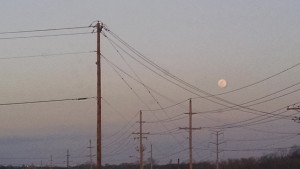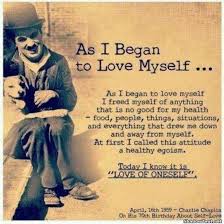
Spring is a good time to remember that each of us was born with the right to be powerful and loving. Spring shows us the powerful fullness of life always waiting beneath. Many seeking counseling learned that being loving was OK, but being powerful wasn’t. Consequently, their power may be hidden beneath.
There’s an interesting notion developed by the Pfieffers, a counseling couple out of Chicago: The Misimprint Theory. The theory suggests that whatever dysfunction we grew up around, we seek in adult relationships.
According to the Misimprint Theory, the mind of a child growing up in chaos, or abuse, neglect, rejection or any other form of dysfunction is misimprinted with the belief that it is only in such dysfunction that love will be found.
Some believe love to be the most powerful force on the planet. Consequently, many believe love is the best solution to every situation. Fundamentally, that seems true, as long as love of self is kept high on the list of who or what to love. In other words, no, we can’t love others too much, but we can inadequately love ourselves.
The studies outlining the measurable, positive effects of love are extensive, from love shown to orphaned babies and love experienced in faith communities, to love creating bonds that literally carry information.
It is my firm belief that love will eventually prevail. And this notion is being studied scientifically by people like Gregg Braden. Mr. Braden’s work suggests the sign wave of love expands over time. To the contrary, it appears the sign wave of fear contracts with time. One could deduce, then, that love literally will prevail.
But since that extrapolation may not be realized for a while, we’re left wondering how best to love.
When to laugh, when to just say no, 
When to keep, when to let it go,
When to hope, when to let it die,
When to sleep,when to dry your eye,
When to climb, when to settle down,
When to play, when to dance around,
When to see, when to close your eyes,
When to be in darkness, when to soar, to fly
Chorus:
I don’t know the answers to these questions
But I know that if I open up my heart,
It will be
I don’t know the answers to these questions
But I know that if I open up my heart,
It will be
Food and the business of eating: curious stuffs. When you think about it, eating is one of the hardest things to force on someone. Consequently, eating holds secret keys. And these keys point to relationships beyond food.
You’ve probably heard someone say, “He’s more in love with his work than me,” or, “She’d rather spend time with the bottle than hang out with me.” These comments suggest we can develop relationships with something other than people. Food is one of those, “somethings.”
Ever settle down in front of a fire with a hot bowl of chili? How often is food the last thing you touch before you fall asleep? Just like any relationship, how we relate to food can be life-giving or life-taking.
- Sleeplessness is often the product of a racing mind.
- If your mind races a lot during the day, it’s not likely to just stop racing when you try to sleep.
- Try to slow your mind down during the day, as a way to ready it for the same thing at bedtime.*
- Your mind slows down and you get drowsy at night on the highway because the signs and posts along the road create a step-down effect on your racing mind, whereby your attention on the road and passing markers give the mind something to train on besides your thoughts.
- Use a simple thought or process when you’re trying to fall asleep to create the step-down effect on your mind that highway signs do.
- As a mental step-down exercise, consider saying the word “love” on every inhale and the word “trust” on every exhale as you fall asleep.
- A racing mind, at any time, is a fear-based response that produces a cascade of hormones in the body whose purpose is to move us to action.
- Action is the last thing we need when trying to sleep.
- Shallow breathing often accompanies fear-based responses.
- Begin any exercise to help you sleep with deep, full breaths.
- Deep, full breaths tell the body, “It’s OK, we don’t need to take action.”
- When the body feels no need to take action, it stops releasing hormones designed to get us moving.
- When hormones intended to get us moving stop coursing through our bodies, we naturally begin to feel heavy in the bed and soon drift into sleep.
Here’s one of the scripts offered in Journey Beyond Hardship to help you fall asleep.
If you like, after you’ve slowed your breathing as suggested above, read the following paragraph to yourself, or have someone read it to you, or record it and play it back when you’re ready to sleep. Remember to be kind with your mind if it wants to race as you read or listen:
My mind is racing to support me, but at this point I’d like to settle down and fall asleep. To help me fall asleep, I am taking deep, full breaths. And as my mind and my breath slow down, I am occupying my mind with this image: I see my electromagnetic field like a large soap bubble attached to the top of my head. With each slow inhale, I see the bubble shrinking, as if my inhale is drawing air into my body from inside the bubble.
As this air from inside the bubble is drawn down through the top of my head, it is converted into a beautiful gold light, like honey. And as I continue to breathe, this honey-like light begins to make its way into every cell of my body, bringing calm and quiet.
First, the honey-like light slowly fills my head, my neck, and my shoulders. As it fills these areas, I feel them relax. Next, the honey drains into my upper arms, then my lower arms and now my hands. And as the light reaches these areas, they relax as if each and every cell is filling with pure love.
Now the honey-like light makes its way into the cells of my upper back and chest, and as it does, I actually feel the muscles there relaxing, receiving the love of this light.
As I breathe in deeply, the bubble above my head gets smaller, and the honey-like light now drains into my middle back and my belly. It feels comforting. As this honey-light pours through me, there is a release of tension as each area is filled and relaxed.
With each deep breath, the golden light makes its way farther down my body, now pouring comfortably into my lower back, my hips, and my groin region. I am finding myself more and more quiet inside as I watch the golden light move through me.
Now the light is in my upper legs and then my knees, and the golden light is filling the cells in my legs with calm and love, and I enjoy the relaxation. And the honey-light continues to pour down into my shins and calf muscles. And now I see that the bubble above my head is nearly completely gone, as each inhale has emptied it, and the activity contained there has been converted into a golden light, like honey, now reaching my ankles and, finally, filling me completely. The sensation I’m left with is one of fullness, relaxation, and pure love.
*Journey Beyond Hardship offers several step-by-step techniques for quieting anxiety and the racing mind.
When we take just the next right step, life gets simpler. By releasing ourselves from the burden of twenty seven steps down the line, our minds can clear a bit. It’s very hard to know what to do next, when the moment is clouded by what to do seven hours or days, months or even years from now. But when we allow our attention to settle gently on just the next right step, there’s room in us to watch, listen and feel for all that’s guiding us in that very moment. And then with seemingly little effort, we move right into the next moment. We’re no longer stuck trying to figure out how this moment intersects with that moment eleven years away.
And once present in the next moment by taking the next right step, another next right step begins to avail itself. Soon the stuckness we felt has begun to move.
And this process begins to flow like water: effortlessly moving to the next place, then the next, surmounting and surpassing any obstacle as if it wasn’t even there. More importantly, this process becomes a way of life, and decisions begin to make themselves.
This approach to life and decisions is often initially met by resistance. So many of us were taught that “figuring it out” would solve all our problems. So we go about searching inside and out for ways to avoid hurt, maximize our assets, and put an end to whatever ails us. Many responded to this just-the-next-right-step approach with rebuffs like, “You have to have a plan,” and “You can’t just let things happen,” and, “Nothing would ever get done if we all thought that way!”
And then they try it. So many stories of people fighting to figure something out, resisting the surrender into just the next right step. And then, after months or years of exhaustion to make some aspect of their life better, they let go of the planning and wrestling. And then something happens in their lives that appears nearly miraculous and the struggle ends with a resolution they’d never dreamt. How?
When we empty our minds of all our plans and projections and plots, there’s room for something completely new.
“Just the next right step” doesn’t have anything to do with being lazy or unwilling to work hard. But when we practice just the next right step, we move forward without resisting ourselves, because the next right step comes naturally as something we want to do. And we have energy to do it, because we haven’t been spending our energy mapping out the course of our lives, and the lives of everybody we know.
Just the next right step opens the door to a level of efficiency and effectiveness you may be surprised by. Feel free to tap into the flow.
My great-niece, Maisey, is a star. Of all that I’ve posted on Facebook over the years, only three posts have broken the 150 mark for views. Two are pictures of Maisey. How come? 
There’s no question, she is a beautiful and precious child. But something tells me it’s more than that. Take a good look at her most recent picture-the one with the blanket partly over her face. What do you see?
Here’s what I see. I see a child so full of love from those around her that it radiates from her. Does she get fussy? Sure, every child does. But there emanates from her something we cannot turn from. I believe it’s love.
We’re like moths to light that way. When we encounter pure love, we can not help but draw to it. Sometimes what we draw to in this way is physically beautiful: majestic mountains, a spectacular sculpture. Other times what draws us is emotionally beautiful, like a couple having a difficult but honest conversation. Perhaps it’s the rawness of this love that captures us. And not just the love between the two halves of this couple, but the love each person must have for self to be this clear and strong with another person.
Any sense can draw us into love: rapturous melody, breathtaking touch, even an earthy smell like horses.
Most people appreciate the love we feel near puppies. But sometimes we’re surprised when love shows up. Have you ever felt a sense of love when a healthy plate of food is put before you? Perhaps it’s the love we feel for and from the person that prepared it. Maybe it’s something emanating from the food itself. After all, some of the healthiest food we eat is still alive when we eat it.
Or what about the love we might feel when witnessing acts of heroism or faith. Even if we don’t share the same beliefs, sometimes we can feel love for someone who has given her or himself to a worthy cause.
But how could we feel lovingly toward someone who doesn’t believe as we do? Love is the answer. I think love, as described in the above ways (and so many millions of other ways) is discernable to us, no matter how disguised. What if love is more than a word or a feeling? What if love is some kind of signal or impulse? And what if each of us is born with the equipment necessary to detect that signal? And what if all the people in all the countries, with all the beliefs and disbeliefs, in spite of their best efforts, cannot turn this equipment off in self or others? What if this unifying signal or tone is the one absolute? And what if that tone is the key to healing the world?
In the first half of this article, we explored my introduction to dream work when living at Pecos Benedictine Monastery during the late 70’s. Two dream experiences there left significant impressions on me. Becky’s story was one of them. A brief encounter with a renowned author who did a quick analysis of one of my dreams was the second.
Becky was being visited in her dreams regularly by a horrific monster that would come down out of the mountains surrounding the monastery and attack her. Initially her fright was paralyzing, but through dream work with her spiritual director, Becky experienced something shift. Using a Gestalt-type dream exercise, Becky eventually was able to imagine talking with the mountain monster. The only thing separating her from the creature, as her active imagination formed the experience, was a wrought iron gate at the entrance to the monastery.
This close encounter with her nightmare monster shifted for Becky a dialogue that was once unfathomable, into an exchange that felt relatively safe.
So, what’s the point? In the Gestalt system of belief, all parts of the dream are highly loaded symbols for parts of the dreamer. For example, in Becky’s dream, the mountains represented some part of her, as did the gate around the monastery, as well as the monastery itself. In keeping with the Gestalt approach, the mountain monster was also representing some aspect of Becky.
What Becky discovered was that the monster represented her own healthy power that she was cut off from. As she became acquainted through the exercise with the mountain monster, she was refamiliarizing herself with this powerful aspect of self. But since Becky had been separate from her healthy power for so long, that power had come to terrify her. This became apparent as Becky activated the mountain monster symbol through the dream exercise.
But as Becky got to know her own power shown to her as the monster, she felt safer in the world. Imagine Becky speaking these words as she role-played the awful beast of her dreams: “I AM THE MOST POWERFUL!” As she felt those words come out of her, Becky began to integrate the strength of her demon. Imagine the force of the mountain monster now her ally.
The second dream work experience that left a lasting impression on me was related to one of my own nightmares. Morton Kelsey was an internationally recognized Jungian author and dream work expert who came to present for all of us living at the monastery back in 1977.
During the presentation break, I was privileged to snag five minutes of Mr. Kelsey’s time. I gave him a brief description of a disturbing dream I’d had. He made one statement about my dream: probably no more than ten words. And while I had some understanding of the meaning of his words at the time, it’s only been in the last year that a more complete comprehension has landed with me. Given only a three minute description of my nightmare, Mr. Kelsey knew something about me that took me almost 40 more years to see.
This is the healing potency of our dream life and why I explore it with clients whenever possible.
Most are familiar with terms like Oedipal Complex and Oral Fixation. These terms were coined by Sigmund Freud, MD. Freud’s approach to dreams tended to focus on our brokenness, as those terms reflect. His acclaimed student, Carl Jung, MD, took a slightly different approach and believed that our dreams showed us more than just our limitations.
Jung was most fascinated with imagery and a skilled artist himself. In observing ancient cave art and petroglyphs from around the world, Jung noticed symbols like the spiral showing up across the globe. His studies also informed him that people from all walks of life and any where in the world might have very similar dream images. He concluded that all humans share access to a core source of wisdom: the Collective Unconscious.
Jung’s student, Fritz Perls, MD, took dream wo rk one step further. Not only did Perls, like Jung, believe that dreams reflected more than our limitations: he believed all of us have an “instinct for wholeness,” and that this push for wholeness is reflected in our dreams.
rk one step further. Not only did Perls, like Jung, believe that dreams reflected more than our limitations: he believed all of us have an “instinct for wholeness,” and that this push for wholeness is reflected in our dreams.
Perl’s fundamental believe in the goodness of humankind won me over and became the cornerstone of my thesis. Operationally, this believe in the wisdom of each person takes the therapist out of the business of “interpreting” dreams, and into the business of supporting others in interpreting their own dreams. This is done by sponsoring clients in exercises that allow aspects of the dream to literally speak for themselves, thereby providing the dreamer with his or her own interpretation.
Are the dreams we have when we’re sleeping just a bunch of nonsense, or is there some method to their madness? Well, it was 33 years ago when I did my master’s thesis on dreaming and experience tells me there’s a lot to be learned through our dream life.
My first real focus on dreaming came in the late 70’s as a Novitiate at Pecos Benedictine Monastery just north of Santa Fe, New Mexico. What a journey in the mountains that was, literally and figuratively. As members of that religious community, each of us had a “spiritual director,” who counseled us. And part of that counsel was an exploration of our dream life.
This particular monastery held the work of psychiatrist Carl Jung, MD, in high regard. Jung was a student of Freud. Jung eventually had his own student, Fritz Perls, MD. I’ll come back to that.
Two distinct memories related to dream work during my life in the monastery come to mind. One was the story of a fellow novitiate. She (yes, this was the only Benedictine monastery in the world at that time that had both men and women living together) shared with all of us a powerful dream experience she had.
Becky described a series of horrible nightmares about a terrifying monster climbing down from deep in the mountains and into her room to attack her. She was absolutely petrified by the thought of this fiendish creature. So together, she and her director began to unravel this recurrent dream.
As part of that unraveling, Becky was taken through an exercise. At the start of the weeks-long process, Becky’s director asked her to imagine somehow communicating with the monster that visited her at night. Becky immediately reacted with tremendous apprehension. It was completely beyond her capability at the beginning of this dream work to imagine the looks of this creature that scared her so, much less speak with it.
[By the way, this form of dream work entailing dialogue with aspects of a dream is fairly common, especially under the Gestalt approach which was formalized by Dr. Perls.]
Becky eventually, through the gentle guidance of her director, found a way to start some kind of communication with the beast of her dreams. Becky called on her active imagination. Surrounding the monastery was a tall, wrought iron fence, with large gates at the main entrance. Becky began her dialogue with the mountain monster by imagining that she could hide behind the gates of the monastery and yell up to it in the mountains. In response, the monster would growl back. Of course, everything in Becky shuttered in these early attempts.
As weeks passed, Becky began yelling questions at the monster in the mountains, and the monster began offering primitive replies. Over time, Becky began to feel some shift, and her communications with the beast felt safer. Later, through role playing, Becky and the monster were visible to each other. And in the end, Becky was standing on one side of the monastery gates and the monster just on the other. That’s a lot of trust. But the payoff of that trust was that Becky discovered something very healing through the dream.
We’ ll continue Becky’s journey and mine next week, along with more information about dream work styles.
Science is pretty clear on this one: love brings healing and wholeness. Fear, anger and doubt bring compromised immune function and unhappiness. So for your sake, why not add more love to your life in the New Year? 
We know from lots of studies that living in a state of peace and love and happiness strengthens our body’s ability to fight disease. The research is so consistent and prolific that most accept it now as common knowledge.
But we forget. We get politically fired up, or fired up on a basketball court, or fired up at a co-worker or neighbor. This is where the research can be a bit tricky to understand.
Research seems to suggest that getting “fired up” or angry isn’t a bad thing. However, if we blow a gasket on a daily basis, or if we hold our anger in and act like everything’s great all the time, then our bodies can pay the price. So it’s not anger itself that’s bad for us. It’s explosive or suppressed anger that will cause physical problems.
Same for sadness and fear. We all have regular occasion to be sad or scared or doubtful. These emotions are part of life. Problems arise, though, when we completely avoid these more difficult emotions, or when we get stuck feeling one for long periods.
Sure, there are times in all our lives when we seem to get angry a lot, or we just can’t shake the blues. But the healthier we get, the less fear, anger, doubt and sadness linger.
All emotions deserve a place at the table. Just make sure it’s you sitting at the head.
With practice, each of us is capable of naming individual emotions as they rise up. And mastery comes when we see each emotion simply as a wave that has splashed up from the ocean of our minds. We remain in peace as each feeling crashes the surface of our thoughts, knowing that soon it will return to the deep and quiet ocean it came from.
Our job is to watch these emotion waves rather than become them. When we become each individual wave or emotion, we can get tossed about. However, when we simply watch each wave, we stay calm like the ocean deep; like the deep waters of the still mind.
When we practice this emotional witnessing, we return more quickly to the peace and love always available to us and in us.
So to help add a little love to your New Year, consider trying one or two of these:
- Put your hand on your heart, and feel your own heart beat.
- Feel your lover’s heart beat.
- Make a donation.
- Get a massage.
- Give one.
- Send a card to someone who could really use it.
- Build something; bake something.
- Commit to doing something special next week that you really enjoy.
- Laugh hard.
- Sing.
- Let someone love you in a very specific way.
- Say, “I love you,” with conviction.
- Send loving thoughts to someone you don’t understand.
Here’s to more love, peace and joy in 2016.
Endorsed by two New York Times bestselling authors.”






